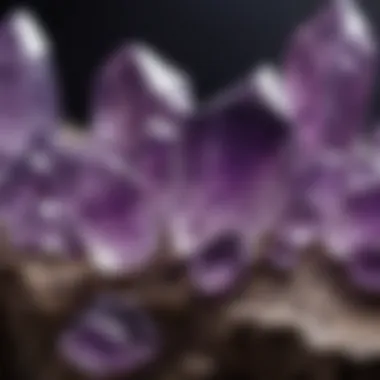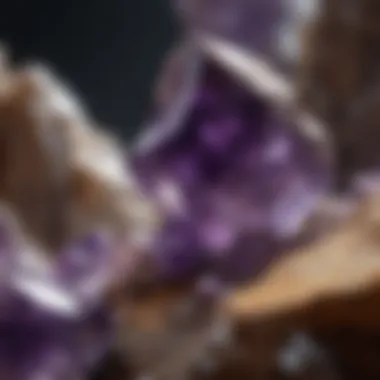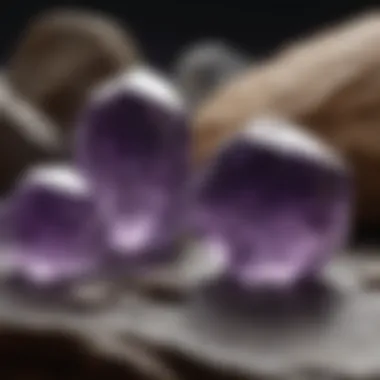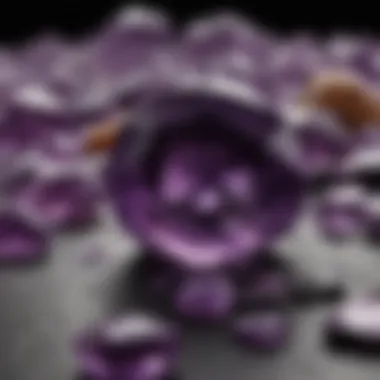Understanding the Worth of Raw Amethyst: Insights


Intro
Understanding the value of raw amethyst involves several multifaceted aspects. This mineral, famed for its stunning hues and unique properties, has been revered throughout history. The perception of amethyst's worth is shaped by various factors that collectors, investors, and enthusiasts must consider.
The geological characteristics contribute significantly to its valuation. Factors such as color intensity, clarity, size, and origin all play crucial roles. In addition, the dynamics of the market can drive fluctuations in pricing, making it essential to be informed about current trends. This exploration aims to dissect these elements, offering insights into the criteria that govern amethyst valuation.
Featured Collectible of the Month
Overview
In this month's feature, we spotlight raw amethyst, showcasing its allure and intrinsic value. Raw amethyst pieces are particularly sought after by collectors due to their natural aesthetics and unique formations. The vibrant purples and occasional inclusions make each piece distinctive.
Historical Significance
Historically, amethyst has held a prominent place in various cultures. Ancient Greeks valued it as a safeguard against intoxication. In the Middle Ages, it was regarded as a symbol of royalty and wisdom. Today, its appeal spans from aesthetic enjoyment to practical applications in holistic practices. Understanding this historical significance enhances appreciation for each collected piece, linking the past with today’s valuation criteria.
Identification Techniques
Visual Characteristics
Proper identification of raw amethyst begins with its distinctive visual traits. Amethyst typically presents in shades ranging from light lavender to deep violet. Key indicators include:
- Color: Saturated hues command higher values. The depth of purple directly correlates to desirability.
- Clarity: Clear stones are more coveted than those with visible inclusions.
- Size: Larger specimens tend to be valued higher, especially if they possess rarity in form.
Resources for Identification
To aid collectors in identifying genuine amethyst, various resources are available. Here are a few notable mentions:
- Gemological Institute of America (GIA): Offers extensive guides and research.
- Reddit: The r/mineralcollectors community can provide peer recommendations.
- Wikipedia: A useful starting point for general information on amethyst.
Identifying and appreciating raw amethyst goes beyond mere aesthetics. It requires an understanding of its geological background and market positioning. As the market continues to evolve, so does the importance of ongoing education and engagement with fellow enthusiasts.
"Understanding the nuances of raw amethyst can empower both collectors and investors. The value isn't just in the stone but in the knowledge behind it."
The complexities surrounding raw amethyst valuation are profound, requiring both a keen eye and an informed mind. Each piece tells a story, rooted in history and defined by contemporary relevance.
Preamble to Raw Amethyst Valuation
The exploration of raw amethyst valuation is pivotal for both novice collectors and seasoned investors alike. Understanding the factors that influence its worth allows individuals to make informed decisions, enhancing their appreciation for this beautiful crystal. Amethyst, with its captivating hues and various geological traits, has a storied place in both historical and modern contexts, often seen as both a decorative item and an investment.
In this section, we will delve into why the valuation of amethyst is not just a straightforward economic endeavor. The multifaceted nature of this mineral demands a thorough comprehension of its characteristics. There are various specific elements that contribute to amethyst's value, such as its color, clarity, size, and geographic origin. Each of these factors plays a crucial role in determining price. Additionally, this understanding helps in recognizing the legitimacy of an amethyst’s provenance and the potential for future appreciation in value.
Collecting amethyst is more than a hobby for many; it's an investment opportunity that can yield significant returns. Hence, articulating the nuances behind raw amethyst valuation enriches the dialogue around its worth. With this knowledge, collectors and investors can navigate their endeavors with greater confidence and insight.
Overview of Amethyst
Amethyst is a variety of quartz, known for its vibrant purple color that varies in intensity. This color comes from the presence of iron and other trace elements within the stone. The term "amethyst" itself is derived from the Greek word "amethystos," meaning "sober." Historically, it was believed to inhibit intoxication and protect the owner from drunkenness.
Its geographical distribution is extensive, with notable deposits found in Brazil, Uruguay, and Zambia. Each location yields different qualities of amethyst, often influencing its market value. Amethyst is not just revered for its aesthetics; it also has significant cultural implications in several societies, symbolizing peace and stability.
Overall, comprehending the essence of amethyst sets the stage for deeper insights into its valuation process, bridging geological characteristics with market dynamics. By the end of this article, the reader will be equipped with a comprehensive understanding of the factors that influence raw amethyst value.
Geological Characteristics of Amethyst
The geological characteristics of amethyst are crucial in determining its value. These traits inform not only how the stone is formed but also its physical attributes that affect its appearance and desirability. Understanding these factors enhances appreciation for raw amethyst, particularly among collectors and investors.


Formation of Amethyst
Amethyst is a variety of quartz that develops through a complex geological process. The formation typically occurs within volcanic rocks over thousands of years. Amethyst crystals grow in pockets or veins inside these rocks. The presence of iron impurities and radiation from surrounding elements cause the distinct purple color of amethyst.
The process begins with magma cooling, which allows quartz to crystallize. As the temperature and pressure fluctuate, conditions become ideal for amethyst to form. These natural processes can vary significantly across different regions, leading to distinct hues and clarity levels in the gemstones. For example, darker purples usually imply a higher concentration of iron. Understanding these geological processes helps collectors evaluate the uniqueness of a raw amethyst specimen.
Physical Properties
The physical properties of amethyst play a direct role in its overall value. These properties include hardness, crystal structure, color, and clarity.
- Hardness: Amethyst has a hardness rating of 7 on the Mohs scale. This makes it relatively durable for handling and setting into jewelry.
- Crystal Structure: The crystal habits of amethyst are typically prismatic or tabular, and formations can be quite varied, impacting its aesthetics.
- Color: The color of amethyst ranges from light lavender to deep purple, with the latter being more sought after.
- Clarity: Transparency is another key factor; more translucent specimens are generally more valuable. Inclusions and fractures can detract from its worth.
Understanding these physical characteristics allows both collectors and appraisers to more accurately assess the true value of amethyst.
When seeking to acquire raw amethyst, it is essential to consider these geological and physical properties. They represent the foundation upon which the market valuation is built.
Overall, geological characteristics provide significant insight into the worth of raw amethyst, thereby enhancing the collecting experience.
Key Factors Influencing Amethyst Value
Evaluating the value of raw amethyst is not a straightforward task. Several key elements contribute to its worth, making it essential for collectors and investors to understand these aspects. Each parameter discussed in this section reveals how the properties of amethyst determine its market price and desirability.
Color Variations
Color is one of the most critical factors in determining amethyst's value. Typically, deep purple shades are the most sought-after, as they indicate high quality. However, variations exist, ranging from pale lavender to intense violet. The precise hue can be influenced by numerous factors, including the amount of iron present in the crystal. Collectors tend to favor stones with uniform color that are free from zoning or uneven patches.
"The richness of color in raw amethyst not only enhances its beauty but also directly correlates to its market value."
Consideration of undertones can also affect valuation. For example, amethyst exhibiting reddish or bluish hues can be perceived differently by various markets. Understanding these color nuances is essential for correctly assessing an amethyst stone's worth.
Clarity and Transparency
Clarity is vital when it comes to valuing raw amethyst. A clear stone free from inclusions typically commands a higher price. Evaluating clarity involves inspecting the crystal under various lighting conditions. Transparency plays a significant role as well; amethyst that allows light to pass through beautifully is generally regarded as more valuable.
Collectors should be cautious of stones that possess visible flaws. Cloudiness or cracks can significantly diminish worth. The more transparent and flawless the amethyst is, the more attractive it becomes for both collectors and investors.
Size and Weight
The size of an amethyst piece impacts its market value. Larger specimens are often more valuable due to their rarity. However, weight can be misleading; a smaller, high-quality piece might be worth more than a larger, lesser-quality stone.
In terms of measurement, amethyst is typically evaluated in carats. Here are some considerations when looking at size and weight:
- Larger specimens generally display higher value, especially if they maintain excellent color and clarity.
- Smaller pieces may still hold significant value if they possess rare attributes.
Origin and Geographic Significance
The geographic location where the amethyst was mined plays a crucial role in its valuation. Certain regions are known for producing particularly high-quality amethyst. For example, amethyst from Brazil is often favored due to its vibrant colors and clarity, while stones from Uruguay are renowned for their deep purples.
Additionally, the mining process, or how ethically sourced the gemstone is, can affect its price. Stones sourced from responsible mining practices tend to garner higher interest and, consequently, a better market value. Understanding where amethyst originates can provide essential context that significantly influences valuation.
Market Dynamics for Amethyst
Understanding the market dynamics for amethyst is crucial for anyone interested in its valuation. These dynamics reflect the interplay of supply and demand, pricing strategies, and the economic factors that influence the market. As the amethyst market evolves, so do the trends and consumer preferences. This section dives into how these elements impact the overall worth of raw amethyst.
Retail vs. Wholesale Pricing
Retail and wholesale pricing play significant roles in amethyst valuation. Retail pricing targets the end consumer and includes a markup that compensates retailers for their costs. Factors affecting retail prices often include the stone's quality, size, and unique characteristics.


In contrast, wholesale pricing occurs when amethyst is sold in bulk to retailers or collectors. Generally, wholesale prices are lower than retail, yet can still vary, depending on supply chain factors. For instance, if demand outstrips supply, wholesalers may raise prices, impacting retailers. Moreover, the relationship between the two types of pricing reveals insights into market health and consumer confidence.
Key Differences:
- Retail Pricing: Higher due to added costs and profit margins.
- Wholesale Pricing: Lower and more flexible based on order volumes and market conditions.
Current Trends in Amethyst Valuation
The current trends shaping amethyst valuation reveal a lot about consumer behavior and market movements. Recently, there has been an increase in consumer interest in crystal healing and holistic practices. This trend has fueled demand for high-quality raw amethyst.
Emerging Trends Include:
- Sustainability: More people want ethically sourced amethyst. This demand can raise the price for stones from sustainable mining operations.
- Online Sales: The internet has opened global markets, allowing collectors to access rare stones more easily. Online platforms have also contributed to price fluctuations based on availability and competition.
- Enhanced Professional Appraisal: As awareness of amethyst attributes grows, so does the reliance on professional appraisers. More accurate assessments directly affect perceived value and can justify higher retail prices.
"Understanding these market dynamics allows collectors to make informed decisions, whether for personal collection or investment."
In summary, the market dynamics for amethyst encompass many factors that can significantly influence pricing decisions. By recognizing the distinctions between retail and wholesale prices, as well as the current trends, collectors and investors can better navigate the complexities of amethyst valuation.
Determining Raw Amethyst Worth
Understanding how to determine the worth of raw amethyst is critical for both collectors and investors. This process goes beyond a mere price tag. It involves a thorough examination of several intrinsic and market-driven factors. Collectors should feel empowered by knowledge, as informed decisions can enhance their collections significantly. Moreover, recognizing the true value of raw amethyst influences not just personal passion but also potential commercial outcomes. Better valuation leads to smarter investments and can result in profitable resale opportunities.
Assessment Techniques
Evaluating raw amethyst requires specific techniques that account for both its physical attributes and external influences. Common assessment practices involve multiple steps:
- Visual Inspection: Careful observation can identify immediate qualities like color, clarity, and size. Bright and vivid hues often indicate higher value.
- Light Test: Holding the stone to light reveals transparency and internal inclusions. The clearer the stone, the more valuable it usually is.
- Weight Measurement: Amethyst is priced by carat weight. Accurate weighing ensures appropriate valuation based on size.
- Professional Grading: Referring to industry standards or grading systems can help assign value more accurately. Grading might indicate if the stone has been enhanced or treated.
- Market Comparison: Analyzing similar stones within the market can provide a benchmark for valuation. Online marketplaces and auctions can offer insights into current pricing trends.
These techniques give a rounded approach to evaluating raw amethyst's worth, ensuring that collectors consider both subjective and objective qualities.
Consulting Experts and Appraisers
When in doubt about the value of raw amethyst, consulting with experts and appraisers can be invaluable. Experts possess specialized knowledge and experience necessary for accurate evaluations. Here are some benefits of engaging with professionals:
- Accurate Appraisals: Experienced appraisers provide precise valuation based on established criteria. They can pinpoint details that may not be apparent to a novice.
- Impartial Advice: Professionals offer unbiased perspectives free from personal attachment to the collector's belongings.
- Documentation: An authenticated appraisal adds legitimacy and can significantly increase resale potential, making it easier to present the stone to potential buyers.
- Market Insights: Experts often have up-to-date information on market trends and demands, which can inform collectors about the best times to buy or sell.
Involving professionals in the valuation process can not only ensure accuracy but can also enhance a collector's confidence in future transactions.
In summary, determining the worth of raw amethyst involves a combination of personal assessment and professional insight. By harnessing both techniques and expert validation, collectors can navigate this complex market effectively.
Caring for Raw Amethyst
Caring for raw amethyst is critical for both maintaining its beauty and preserving its value. Amethyst, with its captivating purple hues, holds significance not just as a collector's item but also in the context of mineral investment. Understanding how to care for this stone enhances its allure and ensures that its qualities remain intact over time. Proper maintenance reflects respect for the mineral itself and appreciation for its natural beauty.
Cleaning and Maintenance
Cleaning raw amethyst requires a careful approach to avoid damage. Here are essential methods to ensure efficient cleaning:
- Gentle Soap Solution: Mix a few drops of mild dish soap with warm water. Use a soft cloth or a gentle brush to clean amethyst. Avoid using harsh chemicals, as they may dull the stone's luster.
- Rinsing: After cleaning, rinse the stone thoroughly under lukewarm running water. This helps remove any soap residue.
- Drying: Gently pat the amethyst dry with a soft lint-free cloth. Avoid air drying, as this can lead to water spots on the surface.
- Storage: Store raw amethyst in a cool, dry place away from direct sunlight. Exposure to sunlight can fade its vibrant color over time.
- Avoiding Scratches: When handling amethyst, be mindful of its surroundings. Keep it away from harder stones to prevent scratches, as these can affect its clarity and appearance.
- Using Proper Containers: When transporting or displaying, consider using soft pouches or lined boxes. This prevents movement and potential damage.
"Taking consistent care of raw amethyst not only retains its natural beauty but also enhances its value among collectors and investors."
Understanding the appropriate practices for cleaning and maintaining raw amethyst lays the groundwork for ensuring that this mineral maintains its aesthetic appeal and monetary worth. It is essential to view care not simply as a chore, but as an investment in both appreciation and value preservation.
Collecting Raw Amethyst


The realm of collecting raw amethyst presents a unique opportunity for enthusiasts and investors alike. This section discusses the fundamental aspects of collecting, emphasizing its benefits, considerations, and the overall significance in the context of amethyst valuation. Collecting amethyst is not simply about acquiring beautiful stones; it also involves understanding their geological origins, market trends, and potential future value. By diving deeper into these facets, collectors can make informed decisions that enhance their collections while ensuring financial prudence.
Tips for New Collectors
For those who are new to collecting raw amethyst, the journey can seem daunting. Here are key tips to consider:
- Do Your Research: Before starting, learn about amethyst types, such as Siberian amethyst or Brazilian amethyst. Understanding the differences will help you make educated choices.
- Start Small: Initially, consider purchasing smaller pieces before investing in more valuable specimens. This strategy aids in getting familiar with market pricing and collection standards.
- Attend Mineral Shows: Visiting rock and mineral shows can enhance your knowledge. Interacting with experienced collectors and vendors provides insights into quality and pricing.
- Quality Over Quantity: Focus on acquiring high-quality pieces rather than assembling a large collection. Clarity, color, and originality often define value.
- Keep Records: Document where and when each piece was purchased. Keeping track of provenance can be helpful for future sales or appraisals.
By adhering to these guidelines, new collectors can navigate the complexities of the collecting landscape and move toward building a meaningful and valuable collection.
Investment and Resale Potential
Investing in raw amethyst can be a rewarding endeavor. The potential for resale hinges on several factors that dictate demand. Here's what to consider:
- Market Demand: The popularity of gemstones can fluctuate. Keeping an eye on market trends can guide timing for selling pieces of your collection.
- Rarity and Quality: Rare varieties tend to appreciate more than common ones. For example, deeply saturated purple amethysts are often more desirable. The clarity and overall condition also play significant roles.
- Appraisals and Certifications: Obtaining reputable appraisals can enhance resale value. Certified pieces provide buyers with assurance regarding authenticity and quality.
- Networking: Building relationships within the collecting community can be beneficial. Fellow collectors may give you leads on potential buyers or upcoming market trends.
The investment potential of raw amethyst remains significant, particularly when attending to the nuances of market demands, rarity, and quality.
Investing in amethyst isn’t just about acquiring beautiful stones. It requires understanding market dynamics and readiness to adapt to evolving trends.
Global Perspectives on Amethyst
Understanding the global perspectives on amethyst is critical for a comprehensive analysis of its value. Amethyst, often cherished for its beauty and rarity, is influenced greatly by its cultural significance and the regions where it is mined. Exploring the mining regions provides insight into the mineral's availability and pricing. Moreover, recognizing its cultural importance across different countries enables collectors and investors to appreciate its value more fully. This section focuses on the elements that shape the global perspective on amethyst, emphasizing both the geological and cultural contexts.
Major Mining Regions
Amethyst is found in several significant mining regions around the world. Each location contributes unique characteristics to the stones harvested there. Some of the notable mining regions include:
- Brazil: Known for producing some of the largest and deepest colored amethysts. Brazilian amethyst tends to have fewer inclusions, enhancing its value in the market.
- Uruguay: The amethyst from Uruguay is highly sought after for its intense purple hue and quality. The region is known for its well-formed crystals found in geodes.
- Zambia: Zambian amethyst often reflects a darker violet shade. This color variation can appeal to certain collectors and can often demand premium prices.
The individual characteristics linked to each mining area can drive demand and subsequently alter the market price. Collectors should be mindful of origins when assessing value, as some regions may command a higher worth based on their reputation and rarity of quality amethyst.
Cultural Significance in Different Countries
The cultural significance of amethyst varies widely around the globe, making it more than just a mineral; it is often viewed as a symbol of wealth, protection, and serenity. In various cultures, amethyst holds unique meanings:
- Ancient Greece: The Greeks believed amethyst could prevent intoxication and promote clarity of mind. This perceived protective quality made amethyst popular among the elite.
- Christianity: In biblical references, amethyst is associated with spiritual awareness, often seen in the episcopal rings of bishops. Its deep purple color signifies royalty and spiritual authority.
- Asia: In some Asian cultures, amethyst is thought to bring peace and tranquility. It is often used in meditation and healing practices, making it a sought-after stone beyond mere aesthetics.
The understanding of amethyst's cultural significance not only broadens its appeal but also adds layers to its valuation. Collectors who consider these aspects can gain a more rounded perspective, leading to more informed decisions.
"Amethyst is not just a beautiful mineral; it embodies cultural stories and historical significance that can greatly influence its value."
Epilogue: The Future of Raw Amethyst Value
The valuation of raw amethyst is a topic of substantial significance. As the market for gemstones evolves, so too does the understanding of what contributes to their worth. This article has comprehensively analyzed various factors impacting the valuation of raw amethyst. Understanding these elements is crucial for both collectors and investors. The future of this gem holds various implications for the market.
Firstly, the demand for raw amethyst is anticipated to grow as consumer preferences shift toward more unique and ethically sourced materials. As people become more aware of the origins of gems, those that are sourced sustainably will likely see their value increase. This shift can result from a greater focus on environmental responsibility and social justice in the mining industry.
Secondly, potential speculation about gemstone investment has become more prevalent. Investing in raw amethyst can present opportunities for collectors looking to diversify their portfolios. However, it is essential to remain cautious and informed. Attention must be given to market trends and valuations influenced by economic conditions.
Lastly, advancements in technology and methods for evaluating gemstones will continue to play a pivotal role. Tools for assessing the quality of amethyst, such as digital spectrometry, may enhance the ability to determine authentic raw materials. This will likely lead to a more informed market, promoting transparency and fairness in pricing.
"Raw amethyst, with its historical significance and enduring popularity, is poised for continued relevance in the gemstone market."
In summary, the future value of raw amethyst hinges on evolving market dynamics, consumer preferences for sustainability, and improved evaluation techniques. For anyone involved in the collection or investment of amethyst, staying updated on these trends is critical to making informed decisions.
Emerging Trends and Insights
Emerging trends suggest a landscape where consumer education and awareness are crucial. Collectors and buyers are becoming more discerning. They are looking not just for beauty but also for quality and ethical sourcing.
- Sustainability Focus: There is a marked shift toward purchasing gemstones that are ethically mined. Consumers prefer gems with traceable origins.
- Online Marketplaces Growth: The rise of online platforms has empowered buyers. They have greater access to information and a broader selection of amethyst types.
- Investment Interest: More individuals view raw amethyst as a viable investment. This trend is driven by its rarity and increasing desirability.
- Cultural Appreciation: Amethyst holds significance in various cultures. As its cultural aspects are brought to light, interest in the stone grows.
These elements are not just trends but represent shifts that could redefine the raw amethyst sector in the coming years. By understanding these changes, investors and collectors can navigate their choices more effectively, enhancing their appreciation of this striking gem.



